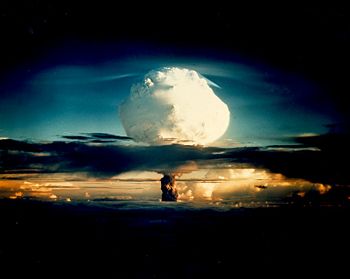Fusion device: Difference between revisions
Jump to navigation
Jump to search

imported>Howard C. Berkowitz No edit summary |
mNo edit summary |
||
| (15 intermediate revisions by 4 users not shown) | |||
| Line 1: | Line 1: | ||
{{subpages}} | {{subpages}} | ||
{{ | {{Image|Ivy Mike.JPG|right|350px|IVY MIKE, the first thermonuclear explosion in which part of the explosive yield comes from nuclear fusion.}} | ||
A '''fusion device''' is any assembly of components that can produce an explosion from [[nuclear fusion]]. A 'fission bomb' can be dropped from an airplane, or at least transported to a real target. In contrast, the first thermonuclear device, Operation Ivy#IVY MIKE|IVY MIKE, detonated on Bikini Island, was not transportable. A '''fusion warhead''' is a device that is sufficiently small and rugged to be used, operationally, as the warhead of a guided missile, artillery|artillery shell, or unguided rocket. | |||
A '''fusion device''' is any assembly of components that can produce an explosion from [[nuclear fusion]]. A | |||
==References== | ==References== | ||
{{reflist|2}} | {{reflist|2}}[[Category:Suggestion Bot Tag]] | ||
Latest revision as of 16:00, 19 August 2024
A fusion device is any assembly of components that can produce an explosion from nuclear fusion. A 'fission bomb' can be dropped from an airplane, or at least transported to a real target. In contrast, the first thermonuclear device, Operation Ivy#IVY MIKE|IVY MIKE, detonated on Bikini Island, was not transportable. A fusion warhead is a device that is sufficiently small and rugged to be used, operationally, as the warhead of a guided missile, artillery|artillery shell, or unguided rocket.
